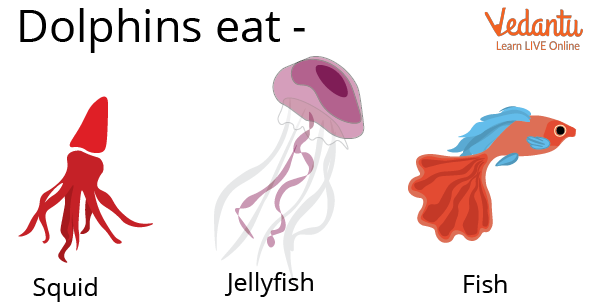




An Introduction to Must-know Facts about Dolphins for Kids
Here we are going to learn about a very beautiful aquatic animal: the dolphin. Do you know dolphins look like fish but they are mammals (females give birth to young ones and feed them their milk)?
Dolphins belong to a large group of animals known as whales. Dolphins can survive in both salt and freshwater. They are found all over the world in marine environments as well as in many river systems. They are warm-blooded and require oxygen to breathe. In this article, we will discuss interesting facts about dolphins and also learn what dolphins eat, and whether they are dangerous creatures or not.

Dolphins
Characteristics of Dolphins
Dolphins are aquatic mammals. They range in size from 1.7-metre-long. Dolphins are small-toothed cetaceans easily recognisable by their curved mouths. Most dolphins are marine and live in the ocean or brackish waters along coastlines but some live in freshwater bodies.
Dolphins can swim quickly; bottlenose dolphins can reach burst speeds of almost 30 km/h (18.5 mph), and common dolphins are even faster. Dolphins can locate objects precisely via echolocation in addition to having superb vision, hearing, and other senses. Clicking, whistling, and other sounds are used by dolphins to communicate with one another.
What Do Dolphins Eat?
Dolphins are active predators; they consume a variety of fish and squid. A dolphin's reach to different foods depends on its location. Dolphins have significant preferences for specific fish species that they eat. Fish and bottom-dwelling invertebrates (spinal cord absent) are typically the main foods of coastal dolphins. Dolphins that live offshore usually consume small fish.
Deep-sea fish were discovered inside the stomachs of certain offshore dolphins. According to this data, offshore dolphins may dive as deep as 500 m. (1,600 ft.). A bottlenose dolphin's daily food intake ranges from 4 to 6 per cent of its body weight. A dolphin's stomach is divided into sections for quick digesting.

Food of Dolphins
Why Are Dolphins So Unique?
Dolphins are highly intelligent creatures that exhibit culture, which was thought to be habits exclusive to humans. Young dolphins have been seen being taught how to utilise tools by adult dolphins. To protect their snouts while foraging, they cover them with sponges.

Dolphins are Unique Creatures
Are Dolphins Dangerous?
Unless provoked or upset by a human, dolphins (both captive and wild) are normally not harmful. In actuality, the majority of dolphins are quiet and friendly, and they get along great with people. Some dolphins enjoy socialising and feeding with people, and they frequently approach small boats to do so.
A killer whale or Orca may occasionally become upset if it is confined, and isolated from those other killer whales, or if a trainer mistakenly provokes or irritates it. Given their size (some killer whales can reach lengths of 25 feet or more), they have never attempted to swallow or eat a person in whole or in part.
Interesting Facts about Dolphins for Kids
The Maui dolphin, which is 1.7 metres (5 feet 7 inches) long and weighs 50 kilograms (110 pounds), to the 10-tonne (11-short-ton) orca, which is 9.5 metres (31 feet 2 inches) long, are the two sizes of dolphins.
Dolphins are thought to be among the most intelligent creatures. Dolphins are carnivores, (meat eaters). The killer whale, commonly called the orca, is a species of dolphin.
The most prevalent and well-known species of dolphin is the bottlenose dolphin. Young dolphins are referred to as calves, male dolphins as bulls, and female dolphins as cows.
Dolphins can live in groups of up to 12 people called schools or pods.
Dolphins frequently exhibit a playful demeanour that makes them well-liked in human culture. They have been observed playing in the water, riding waves, leaping out of the water, and even interacting with people swimming nearby. Dolphins breathe through a blowhole on top of their heads.
Summary
Dolphins are not fish, however, they may glide through the water as beautifully as any fish. Mammals include dolphins. They join the company of other well-known marine creatures including whales, seals, and manatees as a result of this. They breathe through their lungs, not their gills, and have warm blood. They make milk for their young and give birth to live young. They have body hair as well. Like whales, dolphins require occasional surface visits to refuel their air supply. In this article, we have given a detailed description of dolphins. We hope you learnt something new about dolphins today!
FAQs on Interesting Facts about Dolphins for Kids
1. Are there two brains in dolphins?
Dolphins have big brains with two sleeping hemispheres that can do so independently. Studies have demonstrated that one brain hemisphere may exhibit huge, slow brain waves associated with sleep, while the other may exhibit low-level, quick activity associated with wakefulness. Dolphins can sleep in both hemispheres for a brief period, but the great majority of their sleep appears to be unihemispheric. The dolphins can switch between using one hemisphere to produce sound and the other.
2. How do dolphins exchange messages?
The sophisticated ways in which these marine mammals communicate are among their most intriguing characteristics. Whistles, echolocation, and interpersonal communication are the three basic methods. Dolphins use more than simply clicks and whistles to communicate. Additionally, they are capable of breaching, which is defined as slapping the water's surface with their tail or body. Dolphins are capable of a variety of bizarre noises, including buzzes, whistles, clicks, and squeaks. Both navigation and communication are supported by echolocation. The dolphin makes a sound and then waits for the echo as the sound waves that are reflected off of things return to the dolphin.
3. Are some species of dolphins going extinct?
Some dolphin species are in danger of going extinct, frequently as a direct result of human activity. One dolphin species that may have recently gone extinct is the Yangtze River Dolphin. Every year, many dolphins are killed as a result of certain fishing techniques, such as the usage of nets.









